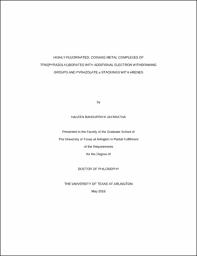
ATTENTION: The works hosted here are being migrated to a new repository that will consolidate resources, improve discoverability, and better show UTA's research impact on the global community. We will update authors as the migration progresses. Please see MavMatrix for more information.
Show simple item record
| dc.contributor.advisor | Dias, Rasika | |
| dc.creator | Jayaratna, Naleen Bandupriya | |
| dc.date.accessioned | 2018-02-01T15:28:22Z | |
| dc.date.available | 2018-02-01T15:28:22Z | |
| dc.date.created | 2016-05 | |
| dc.date.issued | 2016-05-11 | |
| dc.date.submitted | May 2016 | |
| dc.identifier.uri | http://hdl.handle.net/10106/27129 | |
| dc.description.abstract | Tris(pyrazolyl)borates are very popular ligands in inorganic chemistry, bioinorganic chemistry, and organometallic chemistry due to their attractive properties. It is possible to extensively modify the steric and electronic properties of these ligands by changing the pyrazolyl substituent groups. Taking into account the importance and current interest of fluorinated tris(pyrazolyl)borates and weakly coordinating anions in general, three new tris(pyrazolyl)borates, [HB(4-Cl-3,5-(CF₃)₂Pz)₃]-, [HB(3,4,5-(CF₃)3Pz)₃] and [HB(4-(NO₂)-3,5-(CF3)₂Pz)₃]- have been developed (Pz = pyrazolyl). Silver alkene adducts of the ligands have been isolated to evaluate the electronic properties of the ligands and to study their catalytic properties. These adducts found to be the most electron deficient tris(polyazolyl)borates reported. The silver alkene adducts formed by these species are also important due to the scarcity of thermally stable isolable silver ethylene, cis-cyclooctene adducts. Also some of these ligands were used to synthesize copper ethylene and silver carbonyl adducts. The CO stretching frequency of non-classical silver carbonyl adducts appear at a region less sensitive to the ligand electronic effects of tris(azolyl)borate Ag adducts. The alkene ¹³C NMR chemical shift of silver alkene adducts is sensitive to ligand electronic property changes according to the ¹³C NMR. All the silver alkene adducts and a carbonyl adduct were structurally characterized by means of single crystal X-ray diffractions. All the compound reported were characterized by various NMR experiments and elemental analysis. Coinage metal ions supported by highly fluorinated ligands such as fluorinated tris(pyarazolyl)borates are excellent catalysts for carbene insertion into C-H bonds. The activity of silver adducts are particularly noteworthy. The activity and the selectivity of the catalyst can be fine-tuned using the substituents on the supporting ligand. The silver alkene adducts effectively catalyzed the insertion of the carbene moiety of ethyl diazoacetate into C-H bonds of 2,3-dimethylbutane. More electron deficient catalysts have shown higher selectivity towards primary C-H bonds.Moreover our interest was directed towards the chemistry of the primary building block of tris(pyrazolyl)borate, the pyrazolate ligand. This simple ligand has been widely used in inorganic, bioinorganic, and organometallic chemistry. These ligands can strongly bind to the metal ions such as Cu(I), Ag(I) and Au(I). We are interested in the highly fluorinated pyrazolate coinage metal complexes due to the scarcity, their reversed π-stacking ability and the remarkable photophysical properties. The π-acid/ π-base adducts of {[3,5-(CF₃)₂Pz]Cu}₃ [Cu₃] and benzene [Bz], mesitylene [Mes] and naphthalene [Nap] have been isolated. They form columnar structures of the type {[Bz][Cu₃]₂}∞, {[Mes][Cu₃]}∞ and {[Nap][Cu₃]}∞ in the solid state, and are luminescent. The novel coinage metal complexes, C60{[(3,5-(CF₃)₂Pz)Cu]₃}₄ , C60{[(3,5-(CF₃)₂Pz)Ag]₃}₄ and C60{[(3,5-(CF₃)₂Pz)Au]₃}₄, represent the first coinage metal pyrazolate fullerene adducts to the best of our knowledge. Interestingly, these adducts possess same space group to that of “free” C60 and the crystals are formed in their pure form with no co-crystalized solvent molecules. | |
| dc.format.mimetype | application/pdf | |
| dc.language.iso | en_US | |
| dc.subject | Tris(pyrazolyl)borate | |
| dc.subject | Fluorinated | |
| dc.subject | Coinage metal complexes | |
| dc.subject | Pyrazolate | |
| dc.subject | Copper | |
| dc.subject | Silver | |
| dc.subject | Gold | |
| dc.subject | C60 | |
| dc.subject | Buckyball | |
| dc.subject | Fullerene | |
| dc.subject | Arene | |
| dc.subject | Adducts | |
| dc.subject | Luminescence | |
| dc.subject | | |
| dc.title | HIGHLY FLUORINATED, COINAGE METAL COMPLEXES OF TRIS(PYRAZOLYL)BORATES WITH ADDITIONAL ELECTRON WITHDRAWING GROUPS AND PYRAZOLATE π-STACKINGS WITH ARENES | |
| dc.type | Thesis | |
| dc.degree.department | Chemistry and Biochemistry | |
| dc.degree.name | Doctor of Philosophy in Chemistry | |
| dc.date.updated | 2018-02-01T15:28:22Z | |
| thesis.degree.department | Chemistry and Biochemistry | |
| thesis.degree.grantor | The University of Texas at Arlington | |
| thesis.degree.level | Doctoral | |
| thesis.degree.name | Doctor of Philosophy in Chemistry | |
| dc.type.material | text | |
| local.embargo.terms | 2018-05-01 | |
| local.embargo.lift | 2018-05-01 | |
Files in this item
- Name:
- JAYARATNA-DISSERTATION-2016.pdf
- Size:
- 4.035Mb
- Format:
- PDF
This item appears in the following Collection(s)
Show simple item record


